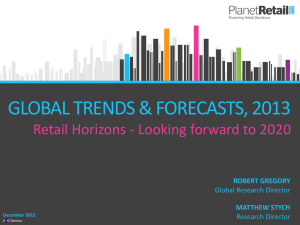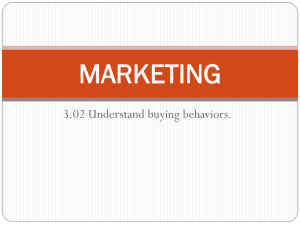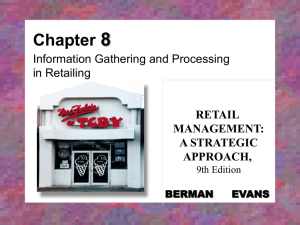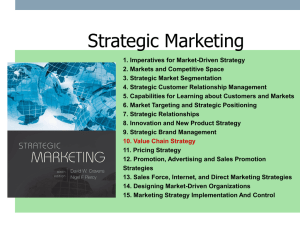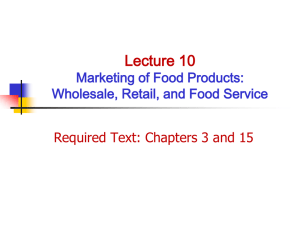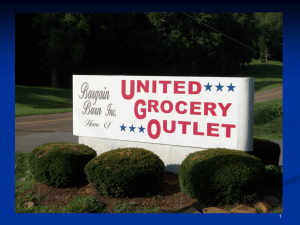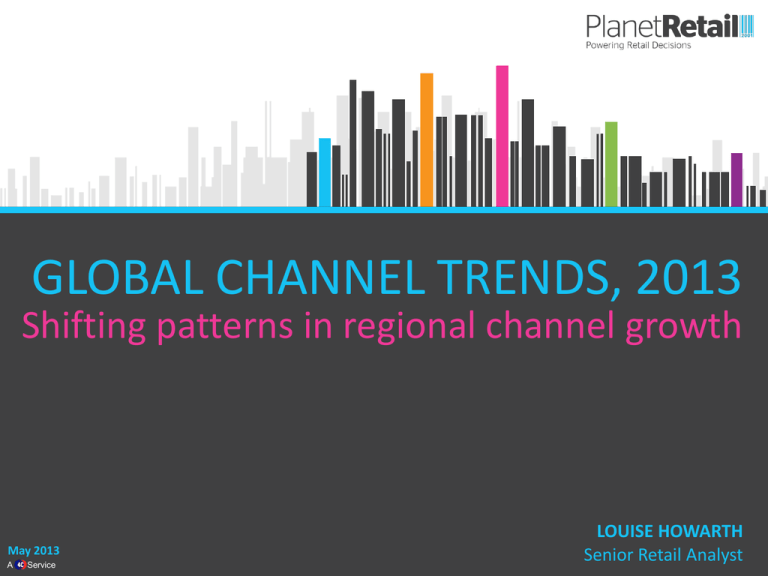
GLOBAL CHANNEL TRENDS, 2013
Shifting patterns in regional channel growth
May 2013
1
A
Service
LOUISE HOWARTH
Senior Retail Analyst
Contents
1.
Introduction
2.
Overview
3.
Regions:
4.
2
1.
Western Europe
2.
Central & Eastern Europe
3.
North America
4.
Latin America
5.
Africa & Middle East
6.
Asia Pacific
7.
Oceania
Summary & Implications
1. Introduction
1. Introduction
Local consumer behaviour and
market influences across the world
are shaping channel trends in
regional markets in different
directions and at varying rates.
Retailer and supplier strategies are
moulded by such factors and, as a
result, instead of a global strategy,
there is a need to tailor approaches
at the local level.
This report looks to highlight key
trends within regions which have
been occurring over the last five
years, as well as pull up opportunity
channels for the future.
4
2. Global Overview
2. Overview
Hypermarkets & superstores remain the largest channel. However, growth is slowing as the
sector becomes saturated. Indeed, all other channels outpace it in terms of the five-year
CAGR. Although still very small in terms of sales, online channel growth has soared over the
last five years and is set to more than double again in the next five.
Global: Channel Sizes by Sales, 2007-2017f (USD bn)
2,500
Retail Banner Sales (USD bn)
2,000
1,500
2007
1,000
2012
2017
500
0
Hypermarkets & Supermarkets & Discount stores Convenience & Cash & Carries & Drugstores,
Superstores Neighbourhood
Forecourt stores Wholesale clubs Pharmacies &
stores
Perfumeries
Online* - Planet Retail’s coverage of Grocery and Health & Beauty e-commerce sales.
Source: Planet Retail.
6
Channel
Online*
2. Overview
Big-box channels have seen relatively low rates of expansion over the last five years
compared to smaller grocery formats such as discount and convenience & forecourt outlets
which have seen strong rates of store openings. This has been driven in part by saturation of
available big-box sites, consumers’ desire for local, convenient shopping and the provision
of online shopping.
Global: Channel Sizes by Outlets, 2007-2017
400,000
350,000
Number of Outlets
300,000
250,000
200,000
2007
2012
150,000
2017
100,000
50,000
0
Hypermarkets & Supermarkets &
Superstores
Neighbourhood
stores
Source: Planet Retail.
7
Discount stores
Convenience & Cash & Carries &
Forecourt stores Wholesale clubs
Channel
Drugstores,
Pharmacies &
Perfumeries
2. Overview
Number of Hypermarket & Superstore Outlets by Region
Though hypermarkets & superstores is the largest channel by Retail Banner Sales (RBS)
globally, regional charts show huge disparities between the number of outlets, and the rate
which they are increasing, across the world’s regions.
30,000
North America
20,000
30,000
2007
Western Europe
20,000
2007
2012
10,000
2017
0
30,000
20,000
0
Source: Planet Retail.
8
2017
0
LATAM
30,000
2007
2017
Central & Eastern Europe
20,000
2007
2012
2012
10,000
20,000
10,000
10,000
0
2017
0
Africa & Middle East
30,000
2007
20,000
2017
Asia & Oceania
2007
2012
2012
2012
10,000
30,000
10,000
0
2017
2. Overview
Number of Discount Outlets by Region
Discount is the fastest-growing channel by outlet numbers globally. Western Europe leads in
terms of physical presence. However, huge network growth is occurring in all regions as
retailers look to cater to cash-conscious shoppers.
60,000
North America
40,000
60,000
2007
Western Europe
40,000
2007
2017
0
60,000
40,000
20,000
60,000
2007
40,000
2012
20,000
0
Source: Planet Retail.
9
2017
2017
40,000
2007
2012
20,000
Africa & Middle East
60,000
2007
40,000
0
2017
Asia & Oceania
2007
2012
2012
20,000
2017
0
0
LATAM
Central & Eastern Europe
2012
2012
20,000
60,000
20,000
0
2017
2. Overview
Number of Convenience & Forecourt Outlets by Region
The international convenience & forecourt store network is larger than any other channel.
Yet there are clear disparities in total stores per region. Areas experiencing urban booms are
ideal targets for this retail format.
200,000
North America
150,000
200,000
2007
2012
100,000
2017
2007
100,000
2012
50,000
0
0
LATAM
200,000
150,000
2007
100,000
2012
2017
150,000
2007
2012
100,000
2017
50,000
0
Asia & Oceania
Africa & Middle East
200,000
2007
150,000
2007
100,000
2012
100,000
2012
2017
2017
50,000
50,000
50,000
0
0
0
Source: Planet Retail
Central & Eastern Europe
150,000
2017
10
200,000
150,000
50,000
200,000
Western Europe
2. Overview
Taking the Top 10 global retailers as a sample, it is clear the hypermarkets &
superstores channel is gradually declining as a proportion of total revenue as
retailers see more potential in other formats.
Global: Channel Sizes of the Top 10 Global Grocery Retailers by Total Sales,
2007-2017 (USD bn)
100%
90%
Retail Banner Sales (USD bn)
80%
Other
11.2%
Non-store commerce
70%
7.5%
60%
10.4%
10.8%
7.8%
7.7%
50%
40%
Discount stores
30%
60.7%
56.4%
53.2%
2012
2017
20%
10%
0%
2007
Channel
Note - ‘Non-store commerce’ includes e-commerce and other non-store sales such as catalogue and direct.
Source: Planet Retail.
11
Drugstores, Pharmacies &
Perfumeries
Cash & Carries & Wholesale
clubs
Convenience & Forecourt stores
Supermarkets & Neighbourhood
stores
Hypermarkets & Superstores
2. Overview
Proportion of web shoppers who have made grocery purchases online.
Online grocery shopping is most prevalent among shoppers in the Asia region. Growth is
being spurred by retailers embracing e-commerce as young, affluent, tech-savvy
consumers opt to shop via the channel.
11%
27%
10%
8%
10%
33%
7%
13%
7%
Source: Planet Retail’s Online Shopper Survey data.
12
31%
2. Overview
What is driving channel growth rate change?
Consumer behaviour and demand is driving the shift in formats to some extent.
Hectic work/home schedules
Two working
parents
Busy lifestyles
Smartphone/tablet
penetration
Increasing single
person households
Urban dwelling
Commuting
Changing
Demographics
Increasing
access to
technology
Tech-savvy generations
becoming key consumers
Shoppers becoming more informed
Ageing population
13
Home access to the internet
2. Overview
What is driving channel growth rate change?
Market saturation, economic conditions and governmental legislation are also hugely
influential factors on trends in retail channels.
Demand for lower prices squeezing
margins and effecting CAPEX
Greenfield zones
implemented to fight
urban sprawl
Reduced consumer spending
High street
vacancies
Reducing availability of
large, out-of-town sites
Largest players shifting focus on
underdeveloped channels
Barricades put up by
Governments to protect against
influx of multinationals
Aggressive
competition
Emerging markets with increasing household
incomes demanding more investment and choice
Competition commissions
blocking new developments
14
3. Regions
Western
Europe
Central & Eastern
Europe
North America
Asia
Africa & Middle East
Latin
America
Oceania
3.1 Western Europe
3.1 Western Europe Region
Many countries within Western Europe have reached saturation point with
the larger hypermarket & superstores and cash & carry channels due to
changing consumer habits and a lack of available sites.
Western Europe: Channel Sizes by Sales, 2007-2017 (USD bn)
600
Retail Banner Sales (USD bn)
500
400
300
2007
2012
200
2017
100
0
Hypermarkets &
Superstores
Source: Planet Retail
17
Supermarkets &
Neighbourhood
stores
Discount stores
Convenience &
Forecourt stores
Channel
Cash & Carries &
Wholesale clubs
Drugstores,
Pharmacies &
Perfumeries
3.1 Western Europe Region
Key Channel Trend: Customers Craving Convenience
Over the last five years, the convenience & forecourt channel has grown at a
relatively strong rate while other channels have witnessed a slowdown.
While once Western Europe’s urban
dwellers made regular trips to out-oftown hypermarkets, increasingly busy
lifestyles have reduced the amount of
time free to spend on grocery shopping.
Ready to eat, ready to heat food and topup items are increasingly desired at a
local level, spurring the growth of small
formats.
Retailers have been catering to urban
dwellers and commuters by stocking
larger fresh ranges, on-the-go
alternatives to fast food outlets and cafés
as well as essential household items.
18
Planet Retail’s take
Smaller stores generate higher operating costs and therefore squeeze margins,
forcing prices to be pushed higher. However, many multi-channel retailers pledge
one price across the board. As an increasing proportion of sales come from smaller
stores, retailers and suppliers will begin to feel the effect.
The Western Europe region is home to many of the most developed grocery markets
in the world. Grocery channel trends often occur here first. The expansion of small
stores in urban areas, which has been seen in markets like the UK, is predicted to be
a key trend in other regions highlighted in this report.
3.1 Western Europe Region
Opportunity: Blurred Channels
Shoppers’ desire for convenience and adoption of technology is blurring channels in
Western Europe. Forward-thinking retailers are embracing e-commerce, aiming to
make the transition between online and physical stores as seamless as possible.
Customers are choosing the efficiency of
ordering from the sofa/office/commuter
train and - rather than having to choose a
four-hour time slot for home delivery - are
collecting orders at their own convenience
from a local store.
According to Planet Retail E-commerce Shopper Data 14% of
French online shoppers have used the Drive & Collect option.
As the number of Drives increases, this number will rise.
The major French players are taking this one step
further with the Drive format. The numbers of
Auchan’s Chronodrive and Auchandrive locations
are increasing while March 2013 saw it announce
Drive locations for its Simply Market banner. Trials
are also being conducted to find synergies
between Grocery and Drive formats.
19
© Tesco.com
Tesco has 1,500 non-food click & collect sites
including a number of Express stores, covering
85% of the UK. It also offers grocery click & collect
services across 140 outlets.
Tesco advertising aimed at London commuters, emphasising
online shopping options available with smartphone ordering.
Planet Retail’s take
Grocery e-commerce ventures require much investment and profitable returns are
uncertain to say the least – particularly in the short to medium-term. However,
playing the long game will pay off – as Tesco has shown in the last few years (being
the first UK grocery retailer to announce a profit derived from its online operations).
3.2 Central & Eastern Europe
3.2 CEE Region
Between 2007-2012, sales grew impressively across most channels in CEE
with the exception of cash & carries and wholesale clubs which stuttered
somewhat. However, sales are predicted to pick up in the next five years.
CEE: Channel Sizes by Sales, 2007-2017 (USD bn)
180
Retail Banner Sales (USD bn)
160
140
120
100
2007
80
2012
60
2017
40
20
0
Hypermarkets &
Superstores
Source: Planet Retail
21
Supermarkets &
Neighbourhood
stores
Discount stores
Convenience &
Forecourt stores
Channel
Cash & Carries &
Wholesale clubs
Drugstores,
Pharmacies &
Perfumeries
3.2 CEE Region
Key Channel Trend: Convenience Stores Gaining Importance
Over the last five years the convenience sector has been a key fast-growing channel
in many countries across the CEE region.
Convenience stores are traditionally well
established in countries like Poland and
Greece, while being relatively new as a
store concept to consumers in the Czech
Republic, Slovakia, Hungary and Russia.
Carrefour opened 100 franchised Carrefour
Express stores in Poland in 2012 and plans to
continue its store opening programme.
Polish operator Zabka rolled out 600 convenience
outlets between 2010-2012.
Tesco has been introducing Tesco Express stores
in the Czech Republic, Slovakia and Hungary.
X5 Retail Group in Russia is successfully
developing its Perekrestok Express banner in
Moscow and Central Russia.
22
Planet Retail’s take
Though a regional trend, which has been ongoing for the last few years, there is still
massive potential for this format in Russia and in some Balkan countries, like Romania.
Tesco will be the fastest-growing convenience store operator in the region over the
next five years with a 2012-2017 CAGR growth rate of 17.3%. However, the retailer is
unlikely to penetrate the Polish market due to the high level of competition.
Foreign retailers have to adjust their product ranges to local conditions as some
product categories like ready meals have much lower penetration than in
neighbouring Western Europe.
3.2 CEE Region
Opportunity: Wholesalers and local cash & carry operators.
Wholesale and cash & carry operators have the opportunity to expand their retail
networks in order capture the “middle man” revenue between suppliers and local
independents.
Low household incomes means much of the regional population do smaller basket shops,
more frequently. As a result there is still a robust mom & pop retail industry.
Retailers are expanding rapidly, often via a franchise model, in order to establish
themselves within close proximity to as many independent retailer customers as possible.
Eurocash has doubled its number of
franchised abc stores to 5,451 between
2008-2012. This is a strategy the
retailer is pursuing for the future.
Planet Retail’s take
Polish Eurocash supplies over
10,000 owned, franchised and
managed stores. Sales at its
cash & carry stores rose 14.5%
to PLN4.07 billion (USD1.25
billion) with like-for-like sales
growth of 9% in 2012.
23
To boost revenues in its cash
& carry stores, Metro Group
is developing a network of
franchised neighbourhood
stores like LaDoiPasi in
Romania, Fasol in Russia and
Odido in Poland.
The existence of independent shopkeepers is endangered by Discount chains
penetrating small towns. Independent retailers will increasingly seek help from
wholesalers and cash & carry operators to be able to compete.
Targeting more local independents via the franchise route is a smart option for cash
& carry operators hoping to offset declines in sales caused by the struggling
Foodservice sector. Franchisees are often more familiar with the needs of the local
customer while retailers can more easily promote their private label products.
Cash & carry operators have an opportunity to enter the grocery e-commerce
channel as Metro Group’s Makro cash & carry has already done in Poland. A
considerable advantage lies in the dense network of collection points available in
franchise stores.
3.3 North America
3.3 North America Region
Shoppers’ strong focus on value and convenience will spur even greater
activity in the discount and club store sectors. Traditional supermarkets,
meanwhile, will be forced to adapt to evolving consumer interests.
North America: Channel Sizes by Sales, 2007-2017 (USD bn)
1,200
Retail Banner Sales (USD bn)
1,000
800
600
2007
2012
400
2017
200
0
Hypermarkets &
Superstores
Source: Planet Retail
25
Supermarkets &
Neighbourhood
stores
Discount stores
Convenience &
Forecourt stores
Channel
Cash & Carries &
Wholesale clubs
Drugstores,
Pharmacies &
Perfumeries
3.3 North America Region
Key Channel Trend: Cash-strapped Consumers Fuelling US Value
Store Activity.
The discount/value channel registered an 8% CAGR from 2007-2012 versus 3% for
the total US grocery channel as shoppers seek bargains.
Eight leading US value chains added more
than 5,000 stores in the last five years.
Planet Retail projects 7,000 more by 2017.
Value channel operators are aggressively
renovating stores to improve the shopper
experience. Dollar General plans 550
renovations or remodels in 2013.
Consumables are accounting for a rising
percentage of sales as operators add
selections to attract more traffic and drive
shopper frequency.
Lower-price private label selections are
becoming increasingly prominent. Family
Dollar plans to have 1,500 items by yearend, 30% more than a year earlier.
26
Leading US Value Chains: Steadily Adding Outlets
Retailer
2007
2012
Change
Dollar General
8,194
10,482
27.9%
Family Dollar
6,430
7,442
15.7%
Dollar Tree
3,302
4,601
39.3%
Big Lots
1,353
1,500
10.8%
Save-A-Lot
1,191
1,329
11.5.%
Note - Save-A-Lot data includes franchised stores
Source: Company reports; Planet Retail..
Planet Retail’s take
A multitude of shoppers gravitated to value-oriented stores during the recession and
many - along with additional customer - will still be frequenting these outlets as the
economy improves. It will result in strong growth opportunities for value channel
merchandisers and creates a ripe environment for the launch of additional outlets
and store brands.
3.3 North America Region
Opportunity: Retail’s biggest players move to cash in online.
Shoppers’ focus on convenience, value and price is making e-commerce an
increasingly attractive merchandising vehicle for US grocers. And activity is already
on the upswing.
Walmart is to install lockers in 12 US stores to hold
goods ordered online for shopper collection. The
lockers will initially be rolled out on a test basis
starting in summer 2013.
Amazon has been expanding its grocery selection
since its introduction in 2006. Its AmazonFresh
grocery delivery service has been tested in the Seattle
area since 2007.
Target is piloting merchandise delivery and pick-up
models. One test allows shoppers to order and pay
online and pick up products instore. Another allows
for online payment with items shipped from a store
with a same-day delivery option.
Ahold USA’s Stop & Shop division developed a
smartphone application that allows customers
to scan groceries, tally their orders, receive
personalised savings and check-out.
27
Ahold’s Peapod home delivery service has more than 100 virtual
grocery stores at high traffic locations. Customers can order items
by scanning product photos on billboards with their smartphones.
Planet Retail’s take
Grocery e-commerce is in its infancy, but the potential payback is immense.
Shoppers are going online for convenience and savings and retailers that fail to
respond risk being left behind.
3.4 LATAM
3.4 LATAM Region
Larger-format stores clearly generate more sales than any other channel in LATAM.
However, as retailers have begun to “back-fill” inner city areas where space is at a
premium, smaller formats such as discount stores (offering convenience and low
prices) have become the concept of choice.
LATAM: Channel Sizes by Sales, 2007-2017 (USD bn)
180
Retail Banner Sales (USD bn)
160
140
120
100
2007
80
2012
60
2017
40
20
0
Hypermarkets &
Superstores
Source: Planet Retail
29
Supermarkets &
Neighbourhood
stores
Discount stores
Convenience &
Forecourt stores
Channel
Cash & Carries &
Wholesale clubs
Drugstores,
Pharmacies &
Perfumeries
3.4 LATAM Region
Key Channel Trend: Hypermarkets & Superstores Channel Rules.
Continued growth in hypermarkets & superstores over the last five years means the
channel has remained in the top spot in Latin America despite challenges from cash
& carries and discount stores.
Some large conurbations show signs of
saturation and, as a result, retailers are
looking beyond the major cities.
Second tier cities with under 50,000
inhabitants have become interesting,
displaying signs of potential for the
short to mid-term future.
© Soriana
Big-box is maintaining its dominance in
the region as the key channel for
expansion by the major players,
although recently in the form of
smaller “compact hypermarkets”.
Planet Retail’s take
Although hypermarkets & superstores continue to dominate, retailers are
increasingly adopting a multi-channel approach.
Cash & carry growth is also thriving in Latin America due to the significant size of the
traditional mom and pop sector and this format’s appeal to low income groups.
About three-quarters of future growth in the hypermarket channel for the whole
region will derive from Mexico and Brazil and be led by Walmart, which has a strong
presence in Mexico, where hypermarkets & superstores are by far the main channel.
30
3.4 LATAM Region
Opportunity: Bodegas
Bodegas take their name from the traditional Latin American/Spanish term for a
grocery store. They fall under the discount channel as their hard line sees them offer a
limited assortment of basic merchandise, focusing on food and housewares, with a
high percentage of private labels.
The Bodega format allows retailers to
reach lower-income consumers in urban
environments.
The smaller size of Bodega stores.
compared to superstores allows the format
to reach consumers from more convenient
locations.
Instore services (bill-paying facilities and
pharmacies) encourage return trips.
Walmart has taken the lead with a variety
of Bodega banners, including Bodega
Aurrera (Mexico), Todo Dia (Brazil) and
Changomas (Argentina).
31
Planet Retail’s take
Bodegas target a growing lower income consumer group with little access to modern
grocery outlets.
Stores need more frequent replenishment than other larger formats – which can be
a problem in emerging countries with poor supply infrastructures.
Bodegas offer a limited assortment. Often shoppers need to frequent another outlet
in order to buy all the items required.
In the medium term, click & collect could be implemented in Latin American
Bodegas, particularly in countries like Brazil where e-commerce is booming. This will
offer a factor of differentiation from rivals.
3.5 Africa & Middle East
3.5 Africa & Middle East Region
Though founded on a low base due to the fragmented nature of the market, growth
rates in this region are impressive. Future growth will be spurred as the markets
(particularly in Sub-Saharan Africa) see infrastructure improvements and develop a
more modern grocery distribution system.
Africa & Middle East: Channel Sizes by Sales, 2007-2017 (USD bn)
50
Retail Banner Sales (USD bn)
45
40
35
30
25
2007
20
2012
2017
15
10
5
0
Hypermarkets &
Superstores
Source: Planet Retail
33
Supermarkets &
Neighbourhood
stores
Discount stores
Convenience &
Forecourt stores
Channel
Cash & Carries &
Wholesale clubs
Drugstores,
Pharmacies &
Perfumeries
3.5 Africa & Middle East Region
Key Channel Trend: Modernisation Through Supermarkets &
Neighbourhood Stores
There are over 200,000 so-called Spaza shops (small independent neighbourhood
stores) in South Africa and an estimated three million in the region. Modern market
players mainly expand via supermarkets (rather than hypermarkets).
Consumer habits and restrictions include:
Frequent & small shopping trips and small
product units, due to low car-ownership rates,
small houses and storage problems (e.g.
refrigeration), and unreliable electricity supply.
Factors contributing to retail
modernisation:
Rising incomes, albeit from a low level;
population growth; increased demand for
more sophisticated products; continued
political stabilisation in most countries, and
partial infrastructure improvements.
Planet Retail’s take
With grocery prices traditionally high in this region due to supply chain problems,
populations are looking towards modern supermarkets in the hope they will drive
efficiencies, consequently meaning lower consumer prices.
The lack of a reliable supplier base, predominantly poor infrastructure, low car
ownership and too small a demand for broad product variety mean that
hypermarkets will not a growth segment at this point in time.
34
3.5 Africa & Middle East Region
Opportunity: Suppliers pushing into independent trade
As retail modernisation is slow in Sub-Saharan Africa, suppliers are actively seeking
opportunities to sell through independent channels. These account for 45% of South
African grocery retail, and approximately 80% in Sub-Saharan Africa as a whole.
The estimated three million spaza shops
across Sub-Saharan Africa source most of
their products through cash & carry
outlets. However, the most aggressive
FMCG suppliers have now switched to
direct delivery, which is proving to be a
very efficient route to consumers.
35
© e-spaza.com
Supply chains are best developed across
South Africa and in the 50+ cities with
over one million inhabitants across SubSahara. As retail modernisation continues
at a slow pace (and is only beginning
outside South Africa), the mass market is
most efficiently targeted through
independent spaza shops.
Planet Retail’s take
Outside South Africa, Sub-Sahara continues to be a consumer market of cities, rather than
countries. In an environment of comparatively well-developed infrastructure, income levels
tend to be four to five times above national average in the region’s large cities.
Direct spaza distribution of FMCG products (currently practised by the likes of Coca-Cola,
Diageo, BAT and Oceana) requires field teams of sales representatives who will usually
visit stores once a week and re-stock on the spot. High-value ranges such as tobacco are
usually re-stocked through logistics partners with high levels of safety expertise.
3.5 Africa & Middle East Region
Case study: Shufersal, Israel’s Discount Leader.
Shufersal has played a pivotal role in developing the discount channel in the
country over the last five years.
In 2010-2011, it began to convert Shufersal
Big hypermarkets to Shufersal Deal discount
stores which quickly became a hit with
consumers.
The retailer has no real domestic rival - Alon
Holdings Blue Square pushing a low-price
formula in its Mega hypermarkets does not
pose a significant threat.
Shufersal’s focus on discount formats signals
a major shift in its strategy. Previously, it had
keen to open any format in order to prevent
rivals obtaining locations.
It also operates Shufersal Yesh Discount
stores exclusively catering to the ultraorthodox community.
36
Planet Retail’s take
Social justice protests in Israel have put tremendous pressure on product prices.
Shufersal’s discount stores are a testimony to shoppers’ growing focus on price.
Over the years, discount formats have changed from open market bazaar-style
layouts to sophisticated retail outlets focused on the shopping experience.
Poundstretcher ventured abroad by setting up its first international store in UAE in
2012 – a bold move and one likely to make more international retailers think about
setting up discount stores in the Middle Eastern region.
3.6 Asia
3.6 Asia Region
The two vastly different (yet somehow complimentary) hypermarket & superstore and
convenience channels will remain most important in serving Asia’s grocery needs,
despite discount and cash & carry being the region’s fastest-growing channels.
Asia: Channel Sizes by Sales, 2007-2017 (USD bn)
400
Retail Banner Sales (USD bn)
350
300
250
200
2007
2012
150
2017
100
50
0
Hypermarkets &
Superstores
Source: Planet Retail
38
Supermarkets &
Neighbourhood
stores
Discount stores
Convenience &
Forecourt stores
Channel
Cash & Carries &
Wholesale clubs
Drugstores,
Pharmacies &
Perfumeries
3.6 Asia Region
Key Channel Trend: The Compact Hypermarket Emerges
Despite the growth of convenience, hypermarkets remain the largest sales channel
in Asia. With changing consumer trends and some countries reaching saturation it
will be the Compact Hypermarket concept that is likely to drive sales in the future.
The hypermarket sector is shaped by a mix
of locals like AEON and Seven & I, and
long-established foreign players in the
region like Walmart, Tesco and Auchan.
AEON is the largest hypermarket player in
Asia, with around 800 outlets in 2012,
having driven its expansion through
mergers and acquisitions.
Tesco, Walmart and Carrefour have slowed
down store expansion in China, whereas
Auchan (in partnership with RT-Mart )
plans aggressive expansion especially in
tier 3 and 4 cities.
Planet Retail’s take
Auchan is to expand its hypermarkets in India and China. It has major expansion
plans for China, targeting tier 3 and 4 cities. However, low consumer spending in
these cities and different shopping patterns will be a challenge for the retailer.
Auchan could launch its compact hypermarket concept Auchan City in Asia, which it
already operates successfully in Russia.
Auchan will become the second-biggest hypermarket player in Asia by 2017,
overtaking Walmart, Seven & I and Tesco. It will likely enter new markets like
Vietnam in the next five years.
Japan’s AEON, which acquired Carrefour stores in Thailand 2012, is likely to establish
a foothold through M&A in Indonesia and market entry into Cambodia in 2014.
39
3.6 Asia Region
Opportunity: Young, tech-savvy shoppers spend online.
Across much of Asia, while online spending is small, access to mobile technology is
growing, offering huge potential for players in the e-commerce channel.
Even developed markets like Japan see a
relatively small proportion of grocery
spending directed to the e-commerce
channel, due to traditional cultural
preferences.
That said, potential lies in the huge young
population in many Asian markets. This
more tech-savvy demographic contains
enormous promise for sustained online
development through e-commerce and
m-commerce.
Tesco’s Asian strategy of investing a
significant amount of capex to develop its
e-commerce offering across all
operational markets is a prime example
of how retailers should be thinking.
40
Planet Retail’s take
Set-up costs for online grocery operations in Asia are likely to be considerable,
especially in light of delivery costs, which can be high due to poor infrastructure.
Tesco would be wise to pursue a roll-out of grocery click & collect services if the
venture is to prove profitable. It has already unveiled plans to pilot such services in
Thailand following trials in the UK and Czech Republic.
Planning to launch its e-commerce venture in Shanghai, Tesco will face major
competition from Walmart’s Yihaodian, which already has a strong presence in
Shanghai, specialising in grocery e-commerce.
3.7 Oceania
3.7 Oceania Region
Oceania’s sparse population means there is too small a demand to support a
higher number of big-box outlets, as a result the majority of sales are
generated in the supermarkets & neighbourhood stores channel.
Oceania: Channel Sizes by Sales, 2007-2017 (USD bn)
140
Retail Banner Sales (USD bn)
120
100
80
2007
60
2012
2017
40
20
0
Hypermarkets &
Superstores
Source: Planet Retail
42
Supermarkets &
Neighbourhood
stores
Discount stores
Convenience &
Forecourt stores
Channel
Cash & Carries &
Wholesale clubs
Drugstores,
Pharmacies &
Perfumeries
3.7 Oceania Region
Key Channel Trend: Aldi, Australia’s Discount Giant
Growing at the fastest rate over the last five years has been the discount channel,
thanks largely to Aldi’s Australian operation.
Aldi (Süd) has been on a rapid expansion
drive on Australia’s east coast since its
market entry in 2001, having opened 300
outlets by the end of its last fiscal year.
The retailer has been able to develop
without any real domestic competition.
Its strategy has been to establish a brand
presence in local areas before growing its
reach geographically. As a result, the
retailer is still very much concentrated in
the south-east pocket of Australia.
It sees the potential for approximately
500 stores in the area before looking at
moving further afield.
43
Planet Retail’s take
Traditionally, grocery prices are high in this region due to its geographical distance
from other large land masses and a vast amount of uninhabited territory entailing
increased supply costs, as well as the market’s duopolistic competitive environment.
Aldi’s discount format offers something different to the Australian public – a key
reason behind its success.
Aldi’s market entry and subsequent expansion has been a contributing factor to the
current price war between the major supermarket chains Woolworths and Coles.
3.7 Oceania Region
Opportunity: Convenience & forecourt stores serving the busy consumer.
Though the last five years may have been ruled by the discount channel, a wealth
of opportunity lies in the convenience arena for the future.
The lack of
established
The an
lack of
an established convenience store chain like 7Eleven
in
New
means
there7-Eleven
is a gap in this highly
convenience
storeZealand
chain
like
concentrated grocery market. Foodstuffs’ On The Spot
in New Zealand
means
there
is a gap
chain’s growth
has remained
fairly stagnant
and thus the
arena is still very much dominated by local indies.
in this highly concentrated grocery
market. Growth for Foodstuffs’ On The
Spot chain has remained fairly
stagnant and thus the arena is still
very much dominated by local
independents.
44
© coles.com.au
Australia is massively under-served by
Australia is massively underserved by the convenience
the convenience
channel. Even though
channel. Though the likes of 7-Eleven (which operates over
600 7-Eleven
outlets in the country)
present, the the
major grocery
the likes of
are are
present,
chains have all overlooked the channel in favour of larger
major grocery
chains
for the
supermarket
formats. have,
However, smaller
formats offering
top-up
items
and
pre-made
meals
could
fill a need
most part,those
overlooked
this channel
in from
with busy lifestyles living in Australia’s major urban
. supermarket formats.
favour of districts
larger
Planet Retail’s take
Considering the level of urban development the key countries in the region have
reached it is surprising how underdeveloped the convenience channel is. Smaller
formats offering top-up items and pre-made meals could fill a need from consumers
with busy lifestyles living in Australasia’s major urban districts.
Woolworths and Coles in Australia are both developing their grocery e-commerce
offering and steadily introducing click & collect across their networks.
4. Summary & Implications
4. Summary & Implications
Channel strategies must be tailored on a regional level due to differing
consumer cultures and stages of market development.
However, as an overall trend we are seeing less demand for big-box stores and
greater focus being placed on small, conveniently located outlets complimented by
a wider online offer.
Western European retailers’ profits taking a hit. Retailers operating in developed nations are
struggling to maintain profitability at their larger out-of-town stores as convenience and online
shopping channels prevail. Those operating in developing markets can benefit from being ‘one
step ahead’ when considering whether a similar future lies ahead for their hypermarket format
stores and may wish to adjust their strategies accordingly.
For multinationals, flexibility is imperative. Taking a varied, multi-channel approach reduces
risk when considering the mid- to long-term impact of cultural shifts, changing consumer
patterns, governmental influence, technological developments (and access) and economic
factors. A multi-format strategy also allows a retailer the flexibility to pursue different
opportunities, including market entries, pricing and store locations.
North America & Oceania moving at a slower pace. Not all developed markets are experiencing
consumer acceptance of e-commerce, m-commerce, click & collect and Drive at the same fast
rate as the more densely populated Western Europe. However, retailers should still expect
similar consumer desires – arising from busy lifestyles and access to technology - to emerge.
46
4. Summary & Implications
Local and international suppliers must also be aware of the Channel trends
occurring on a regional level around the world.
Suppliers will need to predict and adapt to changes in Channel trends by taking a
flexible approach to supply and distribution.
Tailor offer for different channels. As already being witnessed at many Discount chains, national
brands are able to penetrate the channel while avoiding cannibalising their own sales at other
store formats by manufacturing products in different pack sizes.
Beware, smaller formats means less shelf space. Suppliers will be required to adapt by offering
retailers appropriately sized products, single or smaller multi-pack sizes and different
promotions (with less of a focus on multi-buy). A reduced amount of space for SKUs also
increases the chance that brands will be dropped by retailers – especially in favour of their own
private label lines.
Profit squeezes passed on to suppliers. As store sizes shrink, retailer margins will be pressed
and the profit squeeze could be filtered through to suppliers.
Online ‘shelves’ should be viewed as complimentary. The burgeoning e-commerce channel
may lead customer buying patterns in the opposite direction, as they are able to buy larger pack
sizes and quantities without the need to consider transporting their purchases home.
47
Author
LOUISE HOWARTH
Senior Retail Analyst
Louise.Howarth@4c.planetretail.net
Louise Howarth is a Senior Retail Analyst based in London, covering the Oceania retail market in addition
to the global electronics and office sectors. She has also spent time in the US supporting Planet Retail’s
North America team. Louise has a Degree in Geography from the University of Leeds in the UK.
Contributing analysts: Milos Ryba, Carlos Hernandez, Rich Mitchell, Manu Ghai, Tatjana Wolff.
48
All images ©Planet Retail Ltd unless otherwise stated.
UNITED KINGDOM
GERMANY
USA
INDIA
CHINA
HONG KONG
JAPAN
AirW1
20 Air Street
London
W1B 5DN
UK
Dreieichstrasse 59
D-60594 Frankfurt am Main
Germany
130 Fifth Avenue
7th Floor
New York
NY 10011
USA
ICC Chambers
4th floor
Saki Vihar Road
Andheri (E)-Mumbai - 400072
India
10-1-202
88 Tongxing Road
Qingdao 266034
China
Suite 3201-03, 32/F, Tower 1
The Gateway, Harbour City
25 Canton Road
Tsimshatsui, Kowloon
Hong Kong
c/o INSIGHT INC.
Atami Plaza 1401
Kasuga-cho 16-45, Atami-shi
Shizuoka 413-0005
Japan
T: +44 (0)20 7715 6000
F: +44 (0)20 7715 6001
E: infoUK@4C.planetretail.net
T: +49 (0) 69 96 21 75-6
F: +49 (0) 69 96 21 75-70
E: infoDE@4C.planetretail.net
T: +1 (212) 201 6700
F: +1 (212) 201 2830
E: infoUS@4C.planetretail.net
T: +91 22 4250 2058
F: +91 22 4250 2034
E: infoIN@4C.planetretail.net
T: +86 (0) 532 8598 1272
F: +86 (0) 532 8598 9372
E: infoCN@4C.planetretail.net
T: +852 2730 0831
F: +852 2735 9787
E: infoHK@4C.planetretail.net
T: +81 (0) 557 35 9102
F: +81 (0) 557 35 9103
E: infoJP@4C.planetretail.net
49
A
planetretail.net
Service
Researched and published by Planet Retail Limited
Company No: 3994702 (England & Wales) - Registered Office: c/o Top Right Group Limited, The Prow, 1 Wilder Walk, London W1B 5AP
Terms of use and copyright conditions
This document is copyrighted. All rights reserved and no part of this publication may be reproduced, stored in a retrieval system or transmitted
in any form without the prior permission of the publishers. We have taken every precaution to ensure that details provided in this document are
accurate. The publishers are not liable for any omissions, errors or incorrect insertions, nor for any interpretations made from the document.


